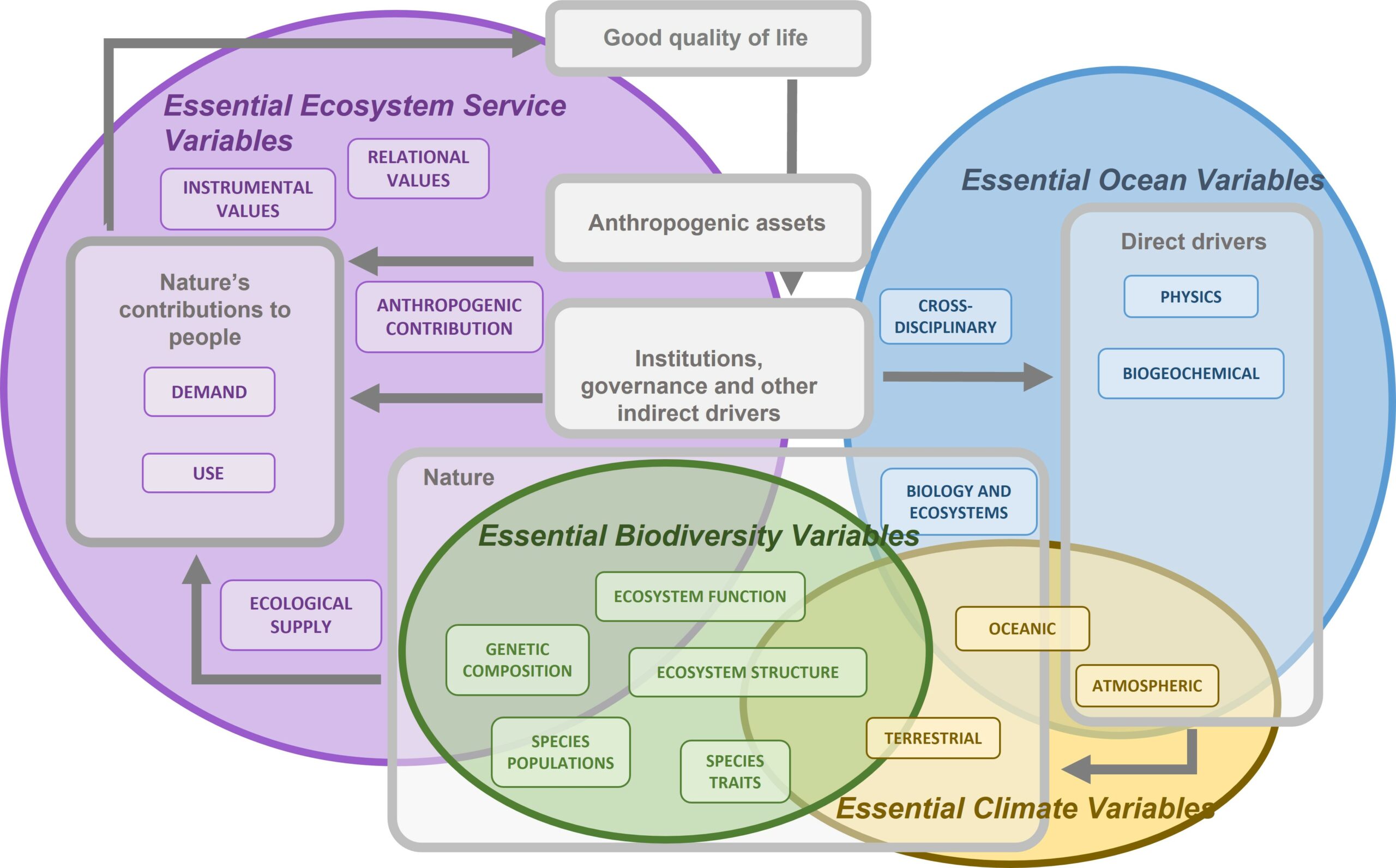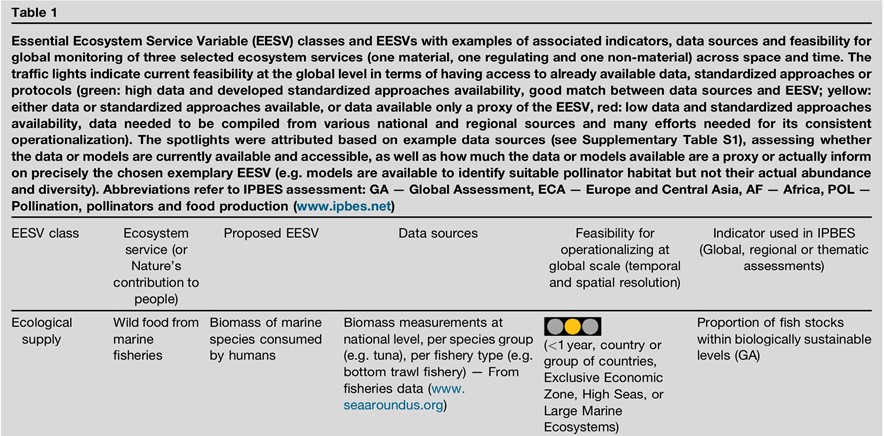Monitoring Essential Ecosystem Service Variables (EESVs) can provide a comprehensive picture of how links between nature and people are changing. The GEO BON Ecosystem Services Working Group (ESWG) has gone through several steps over the past 10 years to iteratively ponder, test, adapt, identify, select, define and explore the feasibility of the operationalization of a first set of EESV classes.
It all started back in 2010 when the ESWG was created. After GEO BON was proposed as a Global Biodiversity Observing System (Scholes et al. 2008) with an important component around Essential Biodiversity Variables (Pereira et al. 2013), the ESWG proposed an early framework for global monitoring of ecosystem service change (Tallis et al. 2012). The team also provided overviews of available approaches and tools to monitor ecosystem services (Balvanera et al. 2017) with some members calling for using earth observations to do so (Cord et al. 2017). The need to address mismatches between monitoring needs and data availability was also put forward (Geijzendorffer et al. 2015).
The ESWG proposed an initial set of EESVs and conducted large consultations with multiple audiences. The most natural audience was the GEO BON growing network: online consultations and face-to-face workshops (when those were still possible) were held in 2015, 2016, 2017 and 2019. In parallel, the team also approached the community undertaking place-based social-ecological sustainability research, under the Program for Ecosystem Change and Society during their 2015 and 2017 annual meetings. Compatibility with efforts undertaken by the United Nations System of Environmental-Economic Accounting was also explored in 2019.
Several iterations led to the definition of a first set of EESV classes, which represent shared and grouped key attributes for all ecosystem services to be monitored across space and time. The proposed EESV classes comprise:
- Ecological supply – the ecosystem structure and functions that underlie the potential capacity of ecosystems to provide ecosystem services,
- Anthropogenic contribution – the efforts that humans invest to enhance ecological supply and to make use of ecosystem services,
- Demand – the explicitly or implicitly expressed human desire or need for an ecosystem service, in terms of its quantity or quality, irrespective of whether awareness exists about such need,
- Use – the active or passive appropriation of an ecosystem service by people,
- Instrumental value – the importance of an ecosystem service to societies or individuals as a means to achieve a specific end (e.g., some dimension of human well-being), and
- Relational value – the importance ascribed to how ecosystems contribute to desirable and meaningful interactions between humans and nature and between humans in relation to nature.

These first EESV classes were tested with regards to their readiness for operationalization at global scales. The analysis included three very different ecosystem services/nature’s contributions to people: food from fisheries (a provisioning/material service/contribution), crop pollination (a regulating service/contribution) and wildlife viewing (a cultural/non-material service/contribution). For each of the EESV classes, one exemplary EESV was selected, followed by the identification of the data sources available, the readiness/feasibility for operationalization, and whether this EESV has been previously used in global initiatives, namely in previous assessments of the Intergovernmental Science-Policy Platform on Biodiversity and Ecosystem Services (IPBES). Based on this analysis, the proposed EESV classes for these three selected services were confirmed to be ready for global operationalization.
The study laying out the EESV framework has been conducted over a number of years and was recently published in Current Opinion in Environmental Sustainability for the use of the entire scientific community and beyond. The team driving this large effort on EESV included Patricia Balvanera, Kate A. Brauman, Anna F. Cord, Evangelia G. Drakou, Ilse R. Geijzendorffer, Daniel S. Karp, Berta Martín-López, Tuyeni H. Mwampamba, and Matthias Schröter. The authors also proposed a set of next steps to move towards a Global Ecosystem Services Monitoring System, in collaboration with other members of the GEO BON community as well as those from the multiple communities working on the monitoring of ecosystem services.

Achieving globally agreed visions of more desirable future, as those embedded in the Sustainability Development Goals, relies on adequately assessing and monitoring the interdependencies between people and nature. The EESV classes will advance our ability to monitor how the declines in the vital benefits that people receive from nature threaten the quality of life of current and future human generations and to develop compelling narratives about how changes in nature across time and space are linked to food and livelihood security, nutrition, economic growth, and cultural heritage.
The EESV publication is now available online (free download until 2 April 2022): https://authors.elsevier.com/a/1eZyZ6gsyPm0oj
Webinar to present EESVs: 8 March 2022, 16:00-17:30 CET!
References
Balvanera P, Quijas S, Karp DS, Ash N, Bennett EM, Boumans R, Brown C, Chan KMA, Chaplin-Kramer R, Halpern BS, Honey-Rosés J, Kim C-KM, Cramer W, Martínez-Harms MJ, Mooney H, Mwampamba T, Nel J, Polasky S, Reyers B, Roman J, Turner W, Scholes RJ, Tallis H, Thonicke K, Villa F, Walpole M, Walz A. 2017. Ecosystem Services. Pages 39–79 in M. Walters and R. J. Scholes, editors. The GEO Handbook on Biodiversity Observation Networks. Cham, Switzerland.
Cord AF, Brauman KA, Chaplin-Kramer R, Huth A, Ziv G, Seppelt R. 2017. Priorities to advance monitoring of ecosystem services using Earth observation. Trends in Ecology and Evolution 32:416–428.
Geijzendorffer IR, Martín-López B, Roche PK. 2015. Improving the identification of mismatches in ecosystem services assessments. Ecological Indicators 52:320–331.
Pereira HM, Ferrier S, Walters M, Geller GN, Jongman RHG, Scholes RJ, Bruford MW, Brummitt N, Butchart SHM, Cardoso AC, Coops NC, Dulloo E, Faith DP, Freyhof J, Gregory RD, Heip C, Hoft R, Hurtt G, Jetz W, Karp DS, McGeoch MA, Obura D, Onoda Y, Pettorelli N, Reyers B, Sayre R, Scharlemann JPW, Stuart SN, Turak E, Walpole M, Wegmann M. 2013. Essential Biodiversity Variables. Science 339:277–278.
Scholes RJ, Mace GM, Turner W, Geller GN, Jürgens N, Larigauderie A, Muchoney D, Walther BA, Mooney HA. 2008. Toward a Global Biodiversity Observing System. Science 321:1044–1045.
Tallis H, Mooney H, Andelman S, Balvanera P, Cramer W, Karp D, Polasky S, Reyers B, Ricketts T, Running S, Thonicke K, Tietjen B, Walz A. 2012. A global system for monitoring ecosystem service change. Bioscience 62:977–986.
